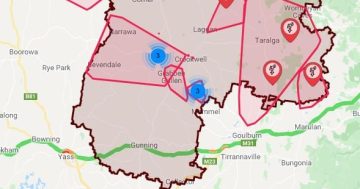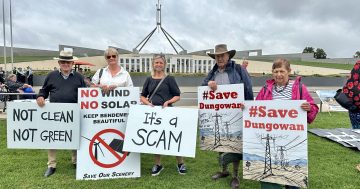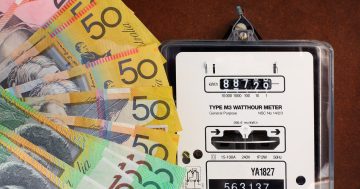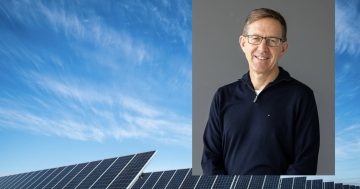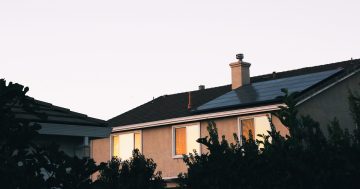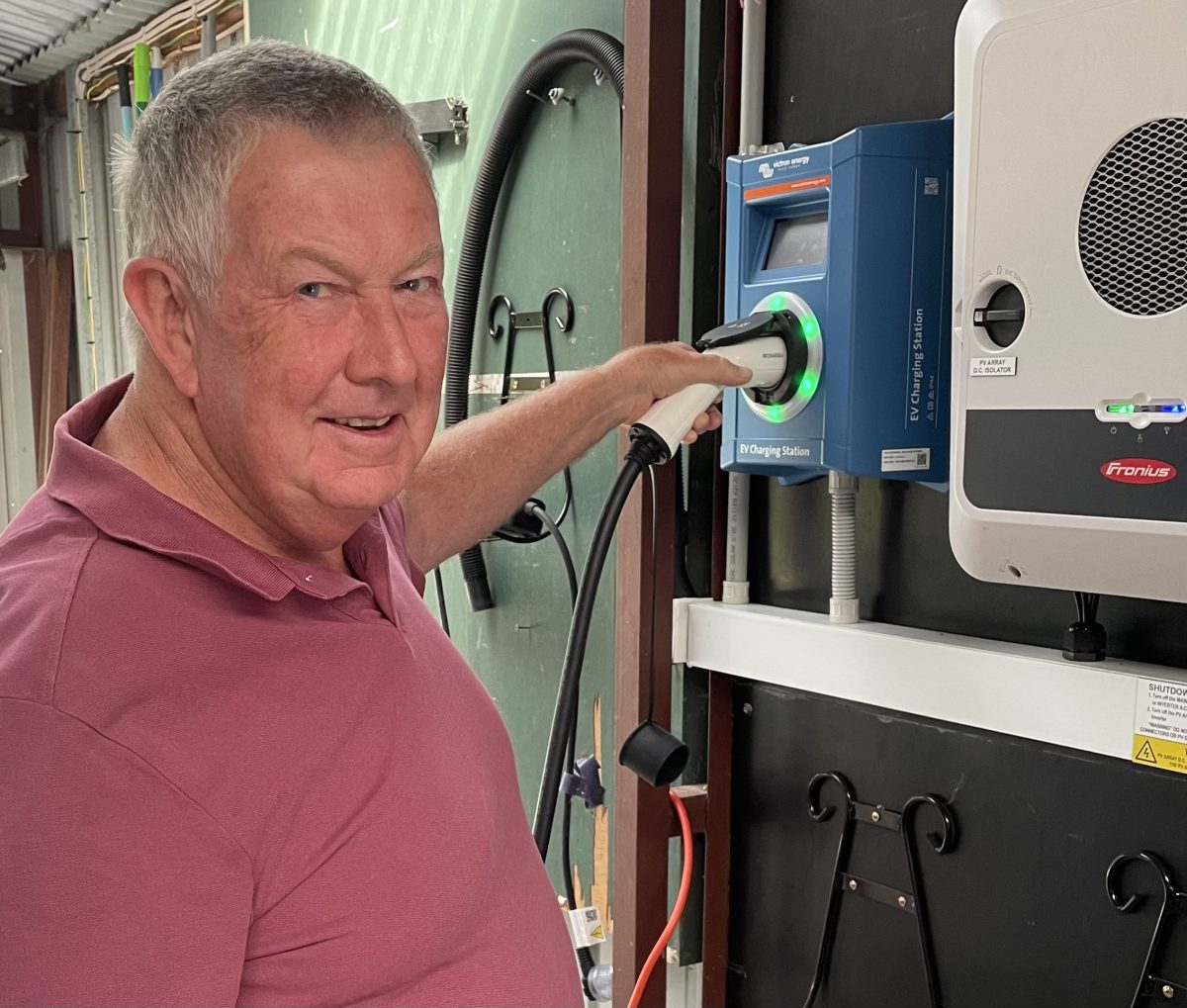
Mark Collins plugging in his electric vehicle at home. Enjoying independence of going off-grid, he recounts only a few scattered solar enthusiasts when he began in 1991, with Tony Egan leading the way. Today Tony is a consultant for off-grid systems with Goulburn Solar. Photo: Christine Johnson.
A chill in the air and shorter days are turning attention in Goulburn to -10-degree Celsius mornings in winter and the rising cost of power. Solar panels are covering more and more rooftops and households are relying on batteries for everything from their toothbrushes and vacuum cleaners to motor mowers, cars and homes.
Now off-grid and having tinkered with solar and wind systems for more than 30 years, Towrang resident Mark Collins says the most satisfying aspect is seeing how much power he is using and how much he is producing for free.
Like the technology for batteries and electric vehicles, monitoring has become easier, available in most cases from mobile phones, and more sophisticated. It’s almost a full-time job at work for Goulburn Solar systems service technician Hami Zadah, who can see what time his electric kettle comes on at home.
Solar has come a long way since Mark, who is not an electrician, connected 12 volts through inverters to 240 volts for his house. “I just did all the wiring and connection myself,” he said. “The house was certified by an electrician, but the County Council back then didn’t care, as long as you weren’t connected to the grid.”
He continued tweaking and improving his solar and wind turbine system with lead-acid batteries, powering everything from kettles to water pumps, until realising if ever he sold his place he would need a conventional off-grid system.
“Since upgrading the system in January 2023 to 29 kW of modern battery power I have virtually no use for LPG (gas),” he said. “Water heating is now by heat pump, cooking by induction cooktops, or air fryers and air conditioners.”
He has also traded in his ute for a BYD Atto 3 Extended Range electrical vehicle and a 6.5 kW charge point.
“Admittedly if the car battery is very low I do not allow it to charge overnight, as it will drain the house battery system,” he said. “But even on overcast days, I can charge the car, the house batteries and run the house. And if all else fails, I still have my old solar system as a backup or plug into the Atto 3 and use the power to run computers, kettles, toasters etc. in a dire emergency.”
Goulburn Solar general manager Richard Joyce said every consultation with customers these days raised the question of electric vehicles. If owners plan charging them at home they will need more solar capacity.
“A single-phase house which is most homes in Australia, will be able to draw at 7 kilowatts from an EV charger, which would be by far the biggest electrical appliance in pretty much any home, except maybe a big, 3-phase air conditioner unit,” he said.
“If you did a full charge it would need 60 kilowatt hours,” he said. “The average NSW home consumes about 20 kilowatt hours in a day, so you are basically tripling your daily consumption just with that one vehicle.”
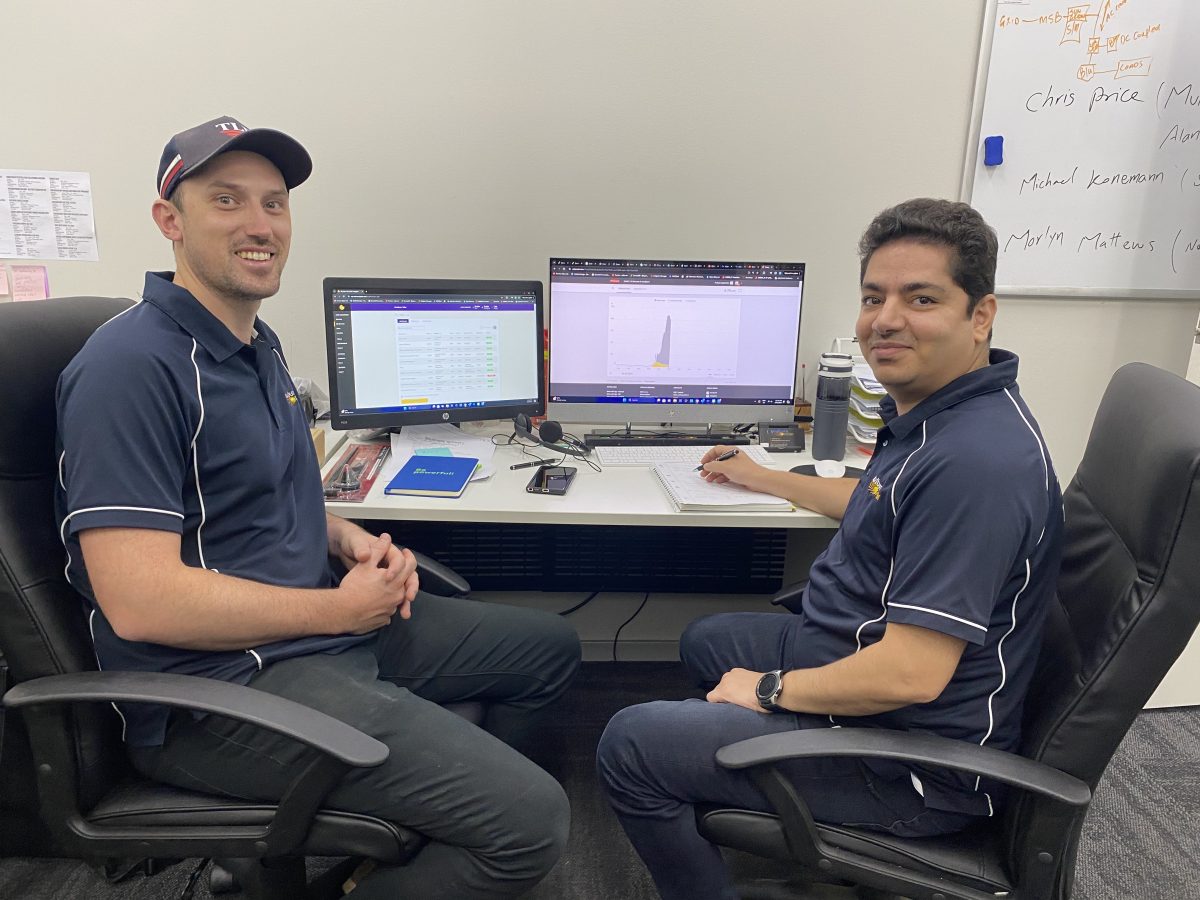
Goulburn Solar’s general manager Richard Joyce and systems service technician Hami Zadeh monitoring a residential solar system in Goulburn. Photo: John Thistleton.
Richard said on average Goulburn households switching to solar were investing about $20,000 for panels and battery systems. If they want to recharge their electric vehicle at home with their solar system they could be spending up to $30,000 to $35,000 for enough generating and storage capacity.
The key to recouping an investment in a solar system for a home over five to seven years, and up to nine years with a bigger outlay for an electric vehicle, is consuming the power you generate.
Phil Joyce, who founded Goulburn Solar said out-of-town installers were offering cheaper but unreliable alternatives than the systems Richard was quoting from; Goulburn Solar was installing industry-leading brands.
“Electrification of the house is in everyone’s thoughts,” Phil said. “People are moving away from gas, looking for some sort of hot water system that is electric. Heat pumps can be supplied through the solar systems as well. They are 80 per cent more efficient than an electric hot water tank. If you couple that with solar, you can heat your hot water for free.”
On overcast days in winter not as much energy comes from solar as it does in summer, nevertheless it is still making a contribution and saving on what is being drawn from the grid.
Power black-outs on the grid are coming and going undetected by people relying on solar systems and batteries. It’s only when they check their system’s monitor they discover an outage, and realise their batteries have been supplying all appliances in their house.









